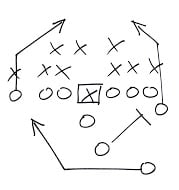The Inbound methodology sounds easy. After all, there are only four steps in actually putting the methodology to use: attract the right people to your website, convert them into leads by offering something of value, close those leads into customers and then delight your customers, turning them into promoters for your business. Piece of cake, right?

Wrong. Many businesses that want to succeed with Inbound, and have committed time and resources to Inbound, aren't seeing results. So what gives?
One thing is clear: It's not from lack of effort. These businesses blog regularly, they're active on social media, they segment their email lists - they're doing all the right stuff. And yet, the results don't come. Often, the problem lies in something called the "strategy-execution" gap. Quite simply, the strategy-execution gap is:
"The gap between current performance and desired performance."
It's the distance between where you are and where you want to be. Put another way, the Inbound methodology is the strategy you use to grow your business, and the HubSpot software is the tool you use to execute that strategy. The problem is an inability to take an Inbound strategy and execute it in HubSpot.
Below are three ways that your company can bridge the gap and head on it's merry way to marketing and sales success.
1. Get your team certified

Before you can start filling in the strategy-execution gap, everyone needs to be speaking the same language. You can't get every single person at a company to adopt a strategic vision if they can't understand each other.
And make no mistake, that means everyone. Sure, Inbound grew up as primarily a marketing strategy, but it's actually much more than that. It's a mindset for sales people and customer support as well. Everyone at your company needs to speak the language of Inbound, not just the marketing team. For example, consider these real-life situations where executing an Inbound strategy falls short:
- The sales reps have no concept of Inbound or an Inbound lead: Marketing works hard to generate Inbound leads, which languish away in the dark corner of a CRM because the "leads are bad." Since the sales reps don't bother to read the marketing intelligence on a contact profile, haven't been trained to work Inbound leads, and can't articulate why certain leads are "bad", it creates bad blood between departments.
- Your customer success team doesn't practice Inbound: Your happy customers, or evangelists, can be an instrumental part of growing your business. Beyond the regular re-sell and upsell value, happy customers will “sell” your vision, product or service to other potential buyers. That’s why loyal customers are worth up to 10x as much as their first purchase. It’s not just their continued purchases, but also their ability to market and sell through their own evangelism. But if your customer success team use intrusive communication, aggressive-upselling tactics, or improperly-timed reach-outs, they could jeopardize the both existing business and future relationships.
The boat can't move unless everyone is rowing in the right direction, and you can't execute a strategy without the alignment of common goals and a unified perspective. The Inbound Certification will ensure that everyone at your business, even those folks who don't spend every day in the tool, can move the company forward with your chosen strategy.
2. Add your personas into HubSpot

What is the most valuable resource at your company?
Nope. Not money.
It's time. Attention.
Why not money, you ask?
Well, there's a saying that Inbound is about the width of your brain, not the width of your wallet. And Buyer Personas, the semi-fictional representation of your ideal buyer, are the most powerful way your business can focus all of their time, and all of their brainpower, on making the right people customers, and keeping them happy.
Personas help your entire company -- in marketing, sales, product, and services -- internalize the ideal customer you're trying to attract, and relate to them as real humans. Having a deep understanding of your buyer persona(s) is critical to driving content creation, product development, sales follow up, and really anything that relates to customer acquisition and retention.
Once you've created your personas (which you can do using this template), it's critical to add them into HubSpot. Otherwise you'll fall into the strategy-execution gap. The hard work your team does won't be in service of a long-term, scalable approach to growth.
The links below will provide you with everything you need to know about intregrating personas into your sales and marketing efforts.
- Project: How to create personas in HubSpot
- User Guide: How to assign personas to your contacts
- Quick Answer: How to add personas with Forms
3. Track the buyer's journey in HubSpot

There are two primary ways that businesses segment their contacts: Who somebody is, and where they are on their path to purchase. If Buyer Personas track who someone is, the buyer's journey tracks where they are on their path to purchase.
The buyer’s journey is the process buyers go through to become aware of, evaluate, and purchase a new product or service. The journey is a three-step process:
- Awareness Stage: The buyer realizes they have a problem.
- Consideration Stage: The buyer defines their problem and researches options to solve it.
- Decision Stage: The buyer chooses a solution.
There are a couple of different ways to track the buyer's journey in HubSpot. The most common is with a property called Lifecycle stage. Lifecycle Stage will help you organize your existing contacts based on where they are in the sales cycle.
They are broader buckets that will help you define whether someone is a subscriber, a lead, ready to be passed over to sales, ready to be worked by sales, likely to purchase, a customer, or an evangelist. You can read more about lifecycle stages here.
If your business has a sales force, they will often use deal stages to provide even more insight into how likely a sales is to occur. This is the second set of stages that will help your sales team close more business. You can read more about deal stages and how to set them up here.
If you're asking yourself, "But how do I combine the lifecycle stages my marketing team uses and the deal stages by sales team uses?", you are not alone. Many businesses before you have asked the same thing, and they look to a tool called lead scoring to solve that problem.
Lead scoring is a methodology used to rank prospects against a scale that represents the perceived value each lead represents to the organization. It can be used to decide when to pass leads to sales, to help sales reps prioritize the leads to work, or signal to marketing that a certain type of lead isn't worth nurturing anymore. It's a data-drive approach to refining the lifecycle stages discussed above. It's a valuable part of executing an inbound strategy, and you can learn more about it using the links below:
- Blog Post: How to score your leads so sales works the hottest prospects
- Project: How to set up lead scoring
In conclusion...
In order for a business to grow, they need to successfully articulate a vision that everyone can believe in, and then provide the tools, training and resources so the team can execute. When the results of your most recent Inbound initiative look different than anticipated, look to the foundational principles of Inbound and see if they've been properly applied to your business.




